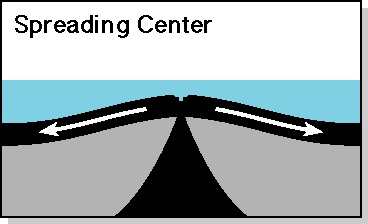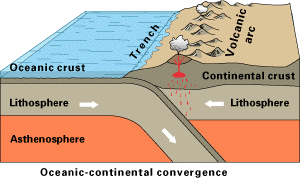Ask GeoMan...
What is plate tectonics?
There are really only two processes: one that forms the physical earth, and another that beats up the surface and tears it apart through weathering and erosion. The formational process is called tectonics, and is manifested to those of us living on earth by earthquakes, volcanos, and mountain building in general.
The earth is really just a sphere of liquid rock (magma) which has cooled to the solid state where exposed to the coldness of space. We call this cold and rigid outer shell the crust, and it is actually rather thin in comparison to the overall diameter of our planet. Because of the heat and pressure beneath the surface, this crust is constantly being subjected to stresses which break it up.
The earth's crustal sections are called plates, and they vary from small to continental in size. Immense forces cause these rigid plates to slowly move about the surface, where they are constantly running into each other. Tectonic activity is common at these plate boundaries, of which there are three basic types:
 Spreading
centers occur where two plates are moving away from each other, and
deep cracks are opened through the crust. This lengthening of the crust
allows magma from the upper mantle to rise to the surface and cool, commonly
forming basalt. An excellent example is
the Mid-Atlantic Ridge. The crust at these "zones of divergence"
is thin and has a high heat flow, so volcanic activity is persistent and
earthquakes are relatively small. Click here
for more information on zones of extensional tectonics.
Spreading
centers occur where two plates are moving away from each other, and
deep cracks are opened through the crust. This lengthening of the crust
allows magma from the upper mantle to rise to the surface and cool, commonly
forming basalt. An excellent example is
the Mid-Atlantic Ridge. The crust at these "zones of divergence"
is thin and has a high heat flow, so volcanic activity is persistent and
earthquakes are relatively small. Click here
for more information on zones of extensional tectonics.
Subduction zones are associated with regions where two  plates are moving towards
each other, and the crust of the earth is shortened. An example is where
the western edge of South America meets the Pacific Ocean. In this case,
the collision is between a continental plate
and an oceanic plate, and a subduction zone forms where the heavier oceanic
basalt is forced beneath the lighter continental materials along a deep
trench. This involves lots of rock being taken back down into the earth,
where it can melt. This leads to a very active volcanic environment. The
crust is much thicker here, and so earthquakes are also stronger. For these
and a variety of other reasons, some of the most intense earthquake and
volcanic activity is associated with these zones of compression. Click
here for more information
on zones of compressional tectonics.
plates are moving towards
each other, and the crust of the earth is shortened. An example is where
the western edge of South America meets the Pacific Ocean. In this case,
the collision is between a continental plate
and an oceanic plate, and a subduction zone forms where the heavier oceanic
basalt is forced beneath the lighter continental materials along a deep
trench. This involves lots of rock being taken back down into the earth,
where it can melt. This leads to a very active volcanic environment. The
crust is much thicker here, and so earthquakes are also stronger. For these
and a variety of other reasons, some of the most intense earthquake and
volcanic activity is associated with these zones of compression. Click
here for more information
on zones of compressional tectonics.
Transform faults are where sections of the crust slide side-by-side past each other. They are usually associated with spreading, and represent horizontal offsets due to the reality of trying to fit a linear zone of faulting onto a spherical earth. The San Andreas Fault of California is THE classic example of one of these "strike-slip" faults, and will surely shake the juice out of the state sooner or later. Because there is no ripping apart or subduction taking place, there isn't any magma formation to lead to volcanos. However, the intensity of the faulting easily makes up for this apparent lack of natural disasters.
For additional details and information...
GeoMan's RCC Continental Drift and Plate Tectonics section
GeoMan's Grants Pass High School Geology Home Page
GPHS class notes on Continental Drift
GPHS class notes on Plate Tectonics: an overview
GPHS class notes on Divergent Plate Boundaries
GPHS class notes on Convergent Plate Boundaries
AskGeoMan: Plate Boundary Summary
Click here to ask GeoMan a question
Return to Ask GeoMan's Index of Questions